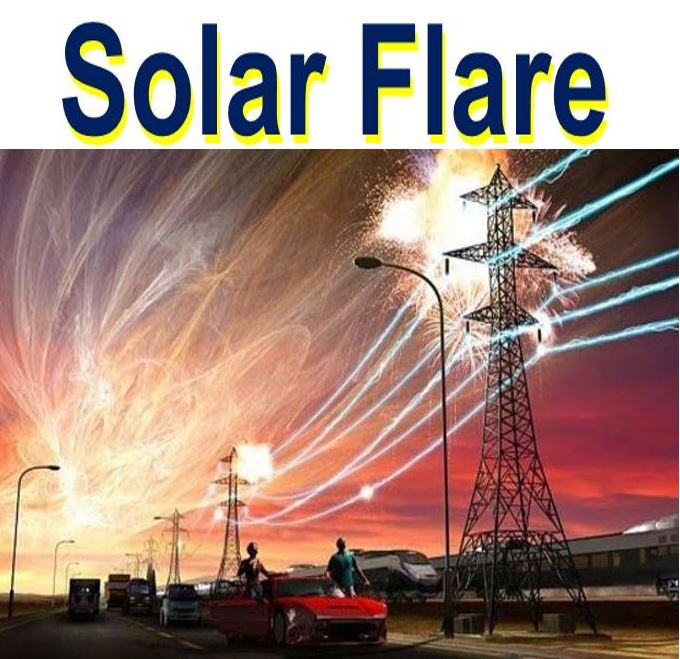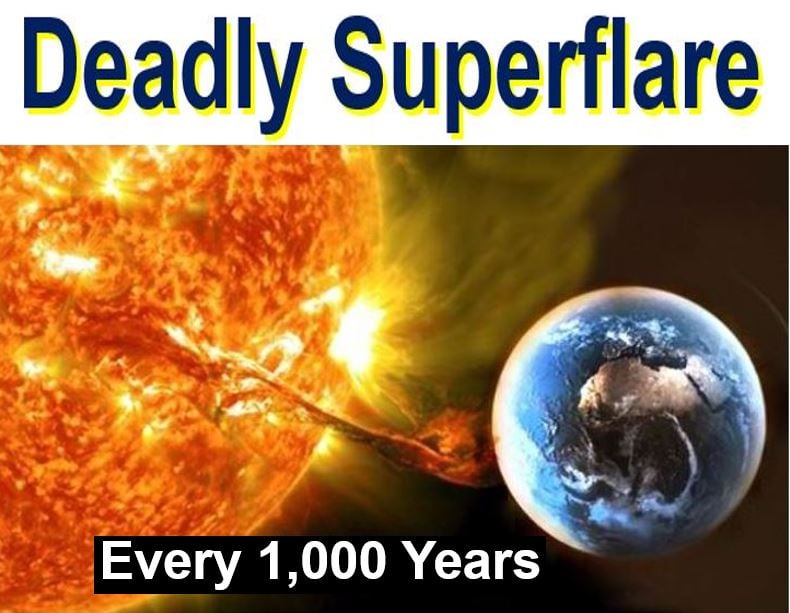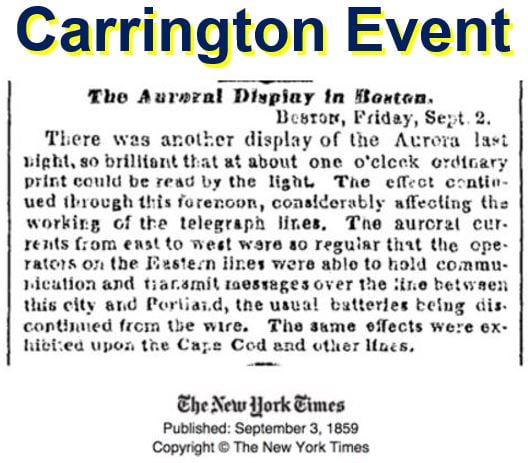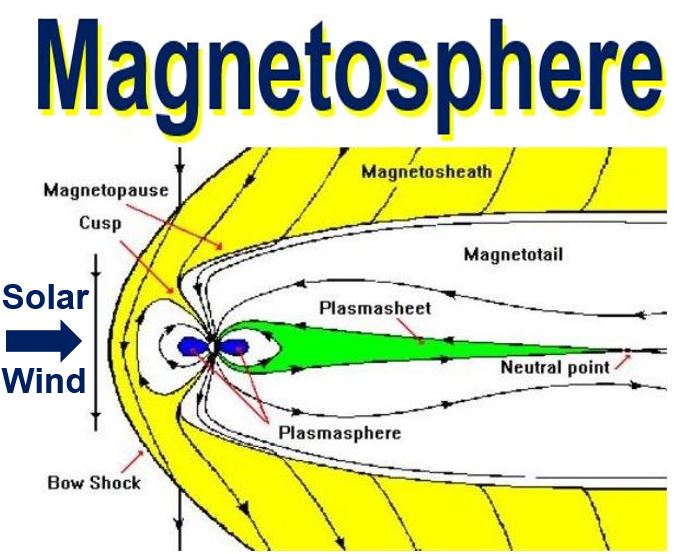A large solar flare could push us all back into the Dark Ages for years, with no internet, satellite communications, mobile or landline telephones, electricity and all the millions of medical and other devices that rely on today’s communications systems and electrical power to operate, says Louis Lanzerotti, distinguished research professor at New Jersey Institute of Technology’s Center for Solar-Terrestrial Research.
Prof. Lanzerotti was speaking at a Symposium of Space Weather that was held in Washington DC last week.
At a push, we would all manage to survive without our smartphones, but how long would we manage with no electricity? What would happen to us if it took several years to get everything back to normal?
 If a catastrophic solar flare reached Earth, the scene would be incredible, even beautiful. However, it would be followed by months or even years with no electricity and other high-tech devices we rely on so much.
If a catastrophic solar flare reached Earth, the scene would be incredible, even beautiful. However, it would be followed by months or even years with no electricity and other high-tech devices we rely on so much.
The specter of a geomagnetic solar storm with the power to disrupt or destroy communications satellites, mess up GPS systems, bring air travel to a halt, turn off telephones, computers and lights in our homes, offices and streets across the world for weeks, months, or even years, is something most members of the general public have no idea about.
However, this is a scenario that insurance companies worldwide, government agencies from national security departments to space agencies to parliaments, and scientists take very seriously.
Those who are aware of the potential problem call it ‘The Big One’ – they say this ‘low probability but high-impact event’ merits a significant push on several fronts, including forecasting, research and mitigation strategy.
Space weather experts come together
The Washington Symposium – Space Weather Science and Applications: Research for Today, Training for Tomorrow – drew space weather experts from the federal government, academia, private industry and the military.
 An artist’s impression of a superflare. A stellar superflare was detected on a nearby star by NASA’s Swift satellite. Had such a powerful flare come from our Sun it would have triggered a mass extinction on Earth.
An artist’s impression of a superflare. A stellar superflare was detected on a nearby star by NASA’s Swift satellite. Had such a powerful flare come from our Sun it would have triggered a mass extinction on Earth.
Regarding a colossal, well-timed solar storm for today’s global society, which is firmly-attached to a high-tech, electrically-powered umbilical crod, Prof. Lanzerotti said:
“Since the development of the electrical telegraph in the 1840s, space weather processes have affected the design, implementation and operation of many engineered systems, at first on Earth and now in space.”
“As the complexity of such systems increases, as new technologies are invented and deployed, and as humans have ventured beyond Earth’s surface, both human-built systems and humans themselves become more susceptible to the effects of Earth’s space environment.”
Apart from disrupting our energy and communication grids, what is generally known as space weather – strong bursts of electromagnetic radiation, magnetized plasma and energetic charged particles – could corrode our water and sewer pipelines, erase everything we have stored in our computer memory, harm astronauts out in space, and undermine security and military operations.
The symposium was sponsored by the Space Policy Institute at George Washington University and the Universities Space Research Association (USRA). It focused on the ever-growing urgency of both the development and creation of practical applications in the field and basic scientific research.
Daniel Baker, Director of University of Colorado-Boulder’s Laboratory for Atmospheric and Space Physics (LASP), said “Once systems start to fail, [the outages] could cascade in ways we can’t even conceive.”
Dr. Baker is also a panelist who recommends greater support for the development and creation of engineering systems and devices that can protect Earth’s infrastructure.
 Scientists from Denmark, Italy and China reported last month that a superflare, like the one observed on other stars, coming from our Sun could destroy much of life on Earth. They believe that Earth suffers the effects of a superflare every 1,000 years. (Image: https://theextinctionprotocol)
Scientists from Denmark, Italy and China reported last month that a superflare, like the one observed on other stars, coming from our Sun could destroy much of life on Earth. They believe that Earth suffers the effects of a superflare every 1,000 years. (Image: https://theextinctionprotocol)
Recovery would cost trillions
A 2013 report published by Lloyd’s of London (Lloyd’s), an insurance market located in London’s primary financial district, estimated that a massive storm would directly affect twenty to forty million people for up to two years, depending ‘largely on the availability of spare replacement transformers’.
To recover from such a solar flare would cost from $600 billion to $2.6 trillion.
This symposium follows one last year – Space Weather: Understanding Potential Impacts and Building Resilience – held in Washington D.C. organised by the Executive Office of the President of the United States and attended by engineers and scientists from industry and academia, as well as politicians and policymakers.
In that symposium, the OSTP laid out a multi-part plan to deal with, as Prof. Lanzerotti put it, ‘civil societal issues related to all aspects of space weather.’ OSTP stands for Office of Science and Technology Policy – it is a department of the United States government, part of the Executive Office of the President.
 The largest solar storm we know of in modern history was the ‘Carrington Event’ in 1859. Northern Lights were seen as far south as Cuba and Honolulu, while Southern Lights were observed in Santiago, Chile’s capital. Telegraph operators reported sparks leaping from their equipment, causing fires in some cases. If such an event occurred today, much of our high-tech infrastructure would be knocked out. (Image: phys.hawaii.edu)
The largest solar storm we know of in modern history was the ‘Carrington Event’ in 1859. Northern Lights were seen as far south as Cuba and Honolulu, while Southern Lights were observed in Santiago, Chile’s capital. Telegraph operators reported sparks leaping from their equipment, causing fires in some cases. If such an event occurred today, much of our high-tech infrastructure would be knocked out. (Image: phys.hawaii.edu)
In an op-ed following last year’s symposium, Prof. Lanzerotti, who was also a panelist, said:
“[The Federal Plan was] impressive for its analyses and coverage of the measurements, data, and models that will be required to ensure security under space weather events of all types—from huge geomagnetic storm-produced telluric currents initiated by coronal mass ejections to solar radio-produced outages of GPS receivers to radiation effects by magnetosphere, solar and galactic radiation to satellite drag effects from Earth’s atmosphere and ionosphere.”
NJIT’s Center for Solar-Terrestrial Research focuses on these areas. It has a variety of instruments on the ground and in space for observing and recording space weather, including the world’s biggest solar optical telescope at Big Bear Solar Observatory, instruments aboard spacecraft in the Van Allen radiation belts, and a solar radio telescope array in Owens Valley in California.
Tamara Dickinson, Principal Assistant Director for Environment and Energy at the OSTP, at a recent symposium described recent minor storms that caused disruption: a blackout in Sweden during which NASA also identified anomalies in deep space missions many years later; the event halted air traffic in Sweden because flight-control systems were interrupted.
 The Earth’s magnetosphere is like a shield, it protects us from solar eruptions. However, it is not strong enough to protect us completely from very large solar flares. (Image: helios.gsfc.nasa.gov)
The Earth’s magnetosphere is like a shield, it protects us from solar eruptions. However, it is not strong enough to protect us completely from very large solar flares. (Image: helios.gsfc.nasa.gov)
Dr. Dickinson said the US Government is at a ‘fundamental turning point’ in how it approaches space weather planning and is prepared to ‘take decisive action to address this risk.’
Ralph Stoffler, Director of Weather, Deputy Chief of Staff for operations at US Air Force headquarters in Washington, said the US Air Force is currently adding to its network of sensors to track space weather, including fitting them onto all of its satellites.
Mr. Stoffler said:
“We need data to support particular military operations. If we can predict space weather, we can have other operations in place or delay.”
Mr. Stoffler explained that the US Air Force relies on GPS for many of its missions, including piloting remote aircraft in Afghanistan from the United States.
How vulnerable are current technology systems?
Policymakers will need to set benchmarks for assessing the vulnerability of different types of technology systems and establishing thresholds that would set off protective or recovery responses, said William Murtagh, Assistant Director for the space weather, energy and environment division at the OSTP.
Working groups are currently focused on these benchmarks amid efforts to reach out to other nations to establish global protocols for aviation conditions, data sharing, and mitigation strategies, among other areas.
Mr. Murtagh said:
“We do not fully understand those upper boundaries, but we need to … once we understand how big these storms are we can develop trigger points.”
Andrew Gerrard, director of NJIT’s Center for Solar-Terrestrial Research, said:
“The technological and biological impacts of severe space weather events are now firmly in the federal government’s sights. All things being equal, increased research funding from the represented federal agencies will further bolster the incorporation of ‘space weather’ into our daily lives.”
“Such development will enable the solar-terrestrial community to, for the first time, see a solar storm, track its approach, and prepare accordingly.”
Video – The risk of catastrophic solar flares
In this four-year-old video, Dr. Michio Kaku was asked to predict the biggest possible disaster for 2012. He said the one threat we should all take seriously is a catastrophic solar flare.

Comments are closed.